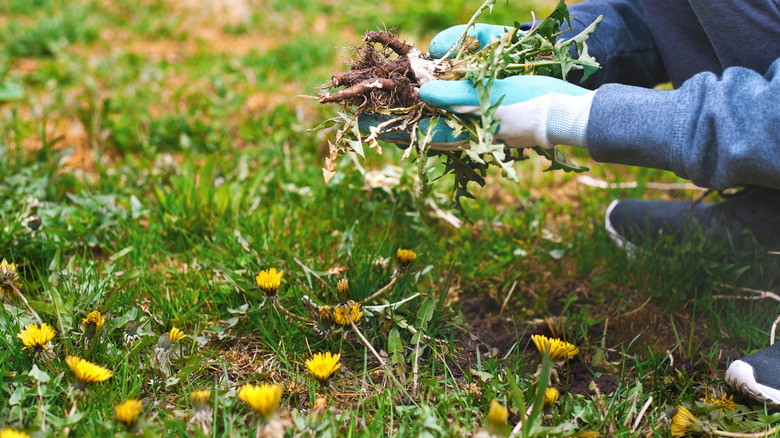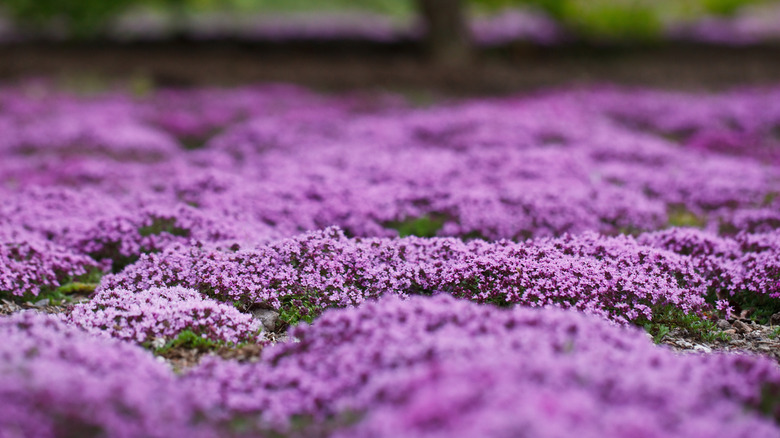The Colorful Grass Alternative That'll Block Out Weeds In Your Yard & Garden
If you're looking for an alternative to traditional grass for your lawn, you may want to consider a colorful option that requires less water and maintenance. Many people are opting for a more natural look to their yards these days; looking for plants that can save water, attract beneficial pollinators, and reduce unnecessary yard work — like weeding. If weeds are taking over your lawn, you're probably looking for a solution. Why spend your weekend working in the yard when you could be relaxing on the patio admiring it instead?
One way to achieve this version of the American dream is by growing groundcovers instead of grasses. In particular, creeping thyme (Thymus serpyllum) is an ornamental, flowering perennial with delicate pink and purple blooms in early summer. It spreads low to the ground, making it a nice replacement for grass in small yards or gardens. Plus, it forms a dense mat that can suppress the growth of weeds better than many types of grass. If you are interested in having a creeping thyme lawn, this may be one of the top reasons to consider it.
Other names this groundcover goes by are wild thyme, mother of thyme, and Breckland thyme. And while the leaves have a fresh and herby aroma, this is not the culinary type of thyme you would cook with. Now let's see how it stacks up as a grass lawn alternative and who it would work best for.
Is this the right thyme to replace the grass in your yard?
Before you pull up your existing grass, consider some of the benefits and pitfalls of planting creeping thyme in your yard. Benefits include the fact that it's drought tolerant and an evergreen, meaning it will stay green all year long if you live in an area with mild winters. In colder conditions, it may go into dormancy, but should return healthy. It's also a prolific spreader in low moisture and could save you a lot of mowing and watering if you plant enough for it to spread widely.
More importantly, the dense, matted canopy it creates effectively blocks weeds and other plants from growing in its space, so check weeding off of your to-do list. In fact, many people consider that a huge advantage for groundcovers in general, but creeping thyme is particularly good at weed suppression. Other benefits are that it's nontoxic (and therefore safe for pets and children) and doesn't attract unwanted fauna like rabbits or deer. Added bonus: butterflies and bees love it!
While creeping thyme can be used as a lawn alternative for smaller spaces, it's traditionally grown as a filler groundcover or along edges and in between rocks. If you do want to replace your lawn with it, keep in mind that it won't stand up to heavy foot traffic. If you have active children who regularly play in the yard, this option may not be best choice. Because it has woody stems with delicate, fuzzy leaves, it could easily be trampled, so it's best to plant away from high-traffic areas.
How to have more thyme in your life
If you're sold on all the positive attributes of this beautiful, adaptable, and endlessly punny groundcover, let's talk basics on getting it settled into your space. You'll need to prepare your plot by removing all existing plants and any landscaping fabric, making sure no grass or weeds are still living in the area. There are many popular methods of lawn removal, so choose one that works best for you.
Creeping thyme should be planted before the first frost in early fall or after the last frost in spring. For best results, choose a site with plenty of sun, at least six hours a day. Whether you start with seeds or transplants, make sure to water them until the plants are fully established. If you're growing several plants as a lawn alternative, space them about 8 inches apart to give them room to spread, but close enough to achieve a good density.
Be careful not to overwater your creeping thyme to keep it safe from root rot. If you had your previous lawn on an automatic sprinkler system, you'll need to adjust it accordingly. Within a year of planting, your thyme shouldn't need any supplemental watering unless you're in a drought stage. Over time, your plants will get leggy and you will want to trim the woody stems back a little bit to encourage new growth. With apologies to the Steve Miller Band: "Thyme keeps on creepin', creepin', creepin' into the fuuuuture."


